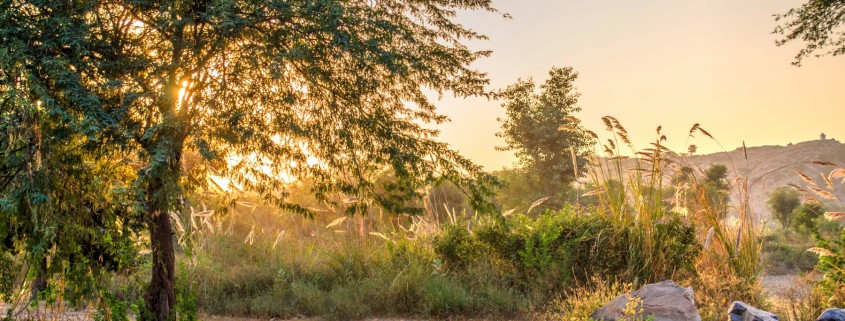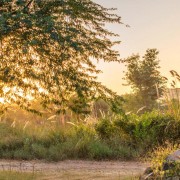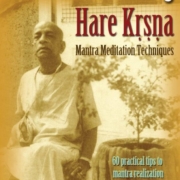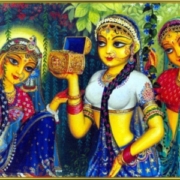Chaitanya Mahaprabhu and Raganuga Bhakti part three
Mahanidhi Swami
- Kamanuga Raganuga Bhakti Sadhana
In three verses only (Brs. 1.2.294-296), Srila Rupa Goswamipada explains the practice of raganuga-bhakti. From these key verses, many more teachings and books on raganuga-bhakti have been written by Sri Jiva Goswami, Srila Narottama dasa, Srila Visvanatha Cakravarti, and especially Srila Raghunatha dasa Goswami. This essay series is based on the teachings of these Gaudiya Vaisnava Mahajana acharyas.
- Three Sadhanas: Smarana, Hari Katha & Vraja Vasa
krishnam smaran janam casya, preshtham nija-samihitam,
tat-tat-katha-ratas casau, kuryad vasam vraje sada (Brs. 1.2.294)
Srila Rupa Goswamipada says, “Remember Vrindavana Sri Krishna, Gopinatha, and His beloved gopis like Sri Radha, Lalita, Sri Rupa and Rati manjari whom you are personally attracted to; absorb yourself in hearing/reading topics about Radha-Krishna, the sakhis and manjaris; and always live in Vraja.”
Second Trans: “The raganuga-sadhaka should remember his own beloved Nandanandana Sri Krishna, and His dear most associates of one’s own choice and taste. He should be attached to speaking about them, and always physically live in Vraja, if possible, or at least mentally.”
Srila Visvanatha Cakravartipada comments:
- krishna-preshtham sva priyatam: The dearmost form of Krishna.
- kishoraṁ nanda-nandanaṁ smaran: One should remember the adolescent son of Nanda Maharaja, Nandanandana Sri Krishna.
- casya bhakta-janam: And the devotees of that particular form of Krishna, who have the same type of desires (for serving Kṛṣṇa) as oneself (nija-samihitam).” The Sanskrit word samihita means desired, wished or longed for.
Does the verse phrase janam casya mean that the sadhaka is free to choose a particular dear bhakta of Krishna whom he desires to follow and serve? Can a raganuga-sadhaka choose any sakhi or manjari that he desires or wishes to follow? For example, one may think, “I like Gopala Bhatta Goswami, so I will follow him in my sadhaka rupa and follow Guna-manjari (his sakhi form) in my manjari siddha deha. And for my sakhi group leader (yuteshvari) I will choose Tungavidya-sakhi.”
The answer is no because the phrase does not indicate a free desire or choice because it’s bestowed or given from outside. In fact, everything in sadhana bhakti from receiving the seed of devotion, bhakti-bija, to receiving the fruit of prema is given or bestowed upon one by the causeless mercy of Sri Krishna or His devotee.
In the very beginning of Chaitanya-caritamrta, Srila Srila Krishnadasa Kaviraja Goswami proves this point when describing Sri Chaitanya Mahaprabhu’s advent. “By His causeless mercy, Mahaprabhu descended in Kali-yuga to BESTOW the most radiant, highest mellow of amorous love (parakiya-bhava) and the treasure of His own [Radha’s] service, karunya avatirnah kalau samarpayitum unnata ujjvala-rasam sva-bhakti sriyam.” (Cc. 1.1.4)
The key words to consider here are karunaya, “causeless mercy”, and samarpayitum which means “to give or to bestow”. It’s not ours to freely choose, “O yes, I want this manjari-bhava, radha-dasyam, seva of Srimati Radharani.” As the verse shows, it is given or bestowed by Krishna Chaitanya to whomever He wants to bless. In essence, the entire life of a bhakti is all causeless mercy from start to finish.
Now let’s apply this principle to the krishna smarana janam casya verse by Srila Rupa Goswamipada. By the causeless mercy of Krishna, a sadhaka may be given or bestowed a place in Nityananda parivara for example, and by that placement he will automatically be under Lalita-sakhi (his yutheshvari) and Sri Rupa-manjari. In Advaita-parivara, it means one will be under Vishakha sakhi and Rati-manjari. Then these sakhis and manjaris will be the role models for the sadhaka to follow. It’s not a matter of free choice.
Sadhakas not given a place in one of the traditional Gaudiya Vaisnava parivaras will have two role models “to choose” from, either Sri Rupa-manjari or Rati-manjari, as Srila Krishnadasa Kaviraja says throughout the Chaitanya-caritamrta, rupa-raghunatha pade yara asha, “My aspiration is for the lotus feet of Srila Rupa Goswamipada and Srila Raghunatha dasa Goswamipada.” Followers of Srila Bhaktivinoda Thakura, for example, generally all follow Lalita-sakhi, Sri Rupa-manjari and Ananga-manjari
In summary, although the verse says “dear most associates of one’s own choice and taste”, the sadhaka actually has NO CHOICE, since it’s all given by higher personalities like Sri Krishna, Lord Gauranga and Sri Guru. As far as which Vrajavasi to follow, it is decided by one’s guru when he receives siddha deha and pranali. For example, the Guru tells his disciple, “your yuteshvari is Vishakha and your main manjari is Rati-manjari. Ok, now it’s settled, given or bestowed, and they become “my favorite or chosen ones whom I desire or wish to follow, serve and emulate.”
Srila Visvanatha Cakravartipada continues: “Smarana (krishnam smaran janam) means remembering the Lord of Vrindavana, Sri Krishna, along with His people. This means one should remember Krishna’s beloved transcendental associates whom the practicing devotee favors like Sri Radhika, Lalita, Vishakha, Sri Rupa or Tulasi-manjari. Although they are Krishna’s favorites, they are also more favorite to those raganuga-sadhakas who desire to enter into ujjvala-madhurya prema of Vraja.” (Raga Vartma Candrika II.11)
REMEMBERING & HEARING ABOUT GOPINATHA AND THE SAKHI MANJARIS
Remembering Krishna is mentioned first (krishna smarana janam casya), because remembering Radha and Krishna is the specialty and the main item in raganuga-bhajana. In essense, raganuga-bhakti is a mental religion, mano dharma. Although Sri Jiva Goswamipada mentions four kinds of smarana (nama, rupa, guna and lila), remembering the lovely pastimes of the Divine Couple is the best because it automatically includes nama, rupa and guna smarana. Thus Radha-Krishna lila-smarana is the main practice of raganuga sadhakas. Besides being the activity for raganuga-sadhakas, smarana is supremely powerful and awards astonishing results.
“Sri Krishna gives Himself to one who remembers (smaratah) his lotus feet, ishvarah smaratah pada pada-kamalam atmanam api yacchati.” (SB 10.80.11) Sri Jiva Goswamipada comments, “Sri Krishna will directly appear before the person who remembers Him and come under his control, sakshat pradurbhuya atmanam smarter vashikarotityartha.” (Bhakti Sandarbhah 277)
Thus, the raganuga-sadhaka should continually remember the divine forms of nitya-kishora Shyamasundara in Vrindavana along with His sweet darlings Sri Radha and the sakhis. One should read about and remember Their pastimes, and the many services rendered to Radharani by Her dearest dasis, the manjaris Sri Rupa, Lavanga and Rati.
By repeatedly hearing, reading and speaking about the bhava and sevas of Sri Radha’s manjaris, deep impressions (bhakti samskaras) of their moods and qualities will form in the mind. As these impressions accumulate, the sadhaka will identify more and more with Radhika’s seva dasis, and then naturally hanker to attain a spiritual form, siddha deha, to lovingly serve Sri Radha for evermore.
RESIDING IN VRINDAVANA
The third sadhana for the raganuga-sadhaka is that he should always live in Vrindavana, kuryad vasam vraje sada (Brs.1.2.295). Since one can practice bhakti anywhere, why does Srila Rupa Goswamipada stress physically living in Vrindavana?
Why, because Vraja Dhama has the inconceivable power to quickly manifest bhava bhakti within the heart of a non-offensive sadhaka residing there, duruha adbhuta virya smin shraddha dure panchake …bhava janmane (Brs. 1.2.238)
The word panchake above refers to the five most potent, result producing limbs of sadhana bhakti, namely nama sankirtana, murti seva, sadhu sanga, hearing Srimad Bhagavatam and living in Vrindavana. Not only will one attain bhava-bhakti by Vraja vasa but also prema. Mahaprabhu explains, “Of all sadhanas, these five limbs of bhakti are the best. Krishna prema will appear in the sadhaka by even a slight association, alpa sanga, with them, sakala sadhana shreshtha ei pancha anga, krishna prema janmaya ei panchera alpa sanga.” (Cc. 2.22.128)
After reading this, the sadhakas who are living in Vrindavana may ask, “How is it then that I have not yet attained bhava, what to speak of prema, even though I have lived in Vrindavana for 5, 10, 15 or 25 years?”
The answer is that there is a certain type of “how to” mood of residence in Vrindavana. Srila Narottama dasa Thakura describes it: “One should live in Vraja with anuraga which means a continuous mood of respect, love and loving attachment; while always desiring to be counted among Srimati Radhika’s sakhis and manjaris, vrajapure anurage vasa, sakhi gana gananate.” (Pr.Bk.Candrika 56).
If one does not have this mood, however, then he will invariably commit offences to the holy dhama or the dhamavasis, and thus have to wait a long time to receive the promised bhava and prema. After one suffers for his aparadhas and deeply repents, then Sri Dhama will eventually forgive, and soon award bhava-bhakti to that sincere sadhaka.
Srila Sanatana Goswamipada reveals the matchless quality of Vraja vasa. While traveling on his spiritual odyssey, Gopa Kumara arrived in Dvaraka in the spiritual sky [not in Gujarat, India]. There he directly saw Krishna and interacted with Him in a very personal way. Nevertheless, Gopa Kumara still felt dissatisfied because there he could not find his coveted “Vraja bhava”.
Feeling compassion for him, Uddhava Mahashaya advised him to go to Gokula Vrindavana in the material world, saying, “When the saintly devotees see the empty forests, rivers, mountains and so on in earthly Vrindavana, they automatically get feelings of humility and love simultaneously. Overwhelmed, and their hearts intensely burning in separation, they loudly cry out “Alas! Alas!” as they search for their dearest Sri Krishna.” (Brhad-Bh. 2.5.242-243)
Upon arriving in this earthly Vraja, Gopa Kumara entered a similar emotional state which he describes here: “I came to Vraja and went to see the many places of Sri Krishna’s pastimes while singing my favorite names of Krishna. While loudly and sweetly singing about Krishna’s pastimes, I fixed my mind upon them. I attained such as state of ecstasy (bhava dasha), and became so emotional that it embarrasses me even to think of it. So how then can I describe this to anyone else?
“In this way, I passed many days and nights. However, I did not know whether my bhajana was bringing me immense joy or immense misery. Was I living in a forest fire or was I submerged in the cooling, sweet waters of Yamunaji? That I cannot say. Then one fine day while I was sitting in a Vraja nikunja doing my bhajana, I became immersed in an ocean of crying and fell unconscious.
“Suddenly dayalu cuda mani Shyama appeared before me. With His cooling nectar hand, Shyama personally wiped the dust from my body. Then Madan Gopaladeva filled my nose with the most uncommon and enchanting fragrance of His divine body. I awoke from my swoon and stood up.
“Vraja Nagara Shyama artfully played a sweet tune on His murali, and before I even knew it, Shyama just disappeared in a kunja. Alas! Alas! I ran behind looking for Him. But Shyama had vanished and I collapsed on the ground!” (Brhad-Bh. 2.6.3-10)
Displaying a similar mood, Srila Raghunatha dasa Goswamipada prays in Stavavali: “When will I wander around Govardhana Hill, constantly crying out like a madman, ‘O Radhe! O Krishna!’ for my most beloved Priya Priyatama? Sometimes I will stumble and fall, and then get up again dancing, singing and crying. O when will the streams of my tears shower these transcendental playgrounds?”
In his Goswami Astakam, Srinivasa Acharya perfectly depicts the mood of the six Vrindavana Goswamis, whom we are trying to follow in our present sadhaka forms (sadhaka rupena): “Greatly agitated and distressed, they wandered everywhere in Vrindavana crying out, “O Radhe! O Vraja Devi! O Lalite! O Nandanandana! Where are You all now? Are You at Sri Govardhanaji, or are You under the desire-trees on the bank of Yamunaji? Where are You?” (he radhe vraja devike ca lalite, he nanda suno kutah)
By the mercy of Sri Guru and Sri Krishna, raganugiya sadhakas who live in Vraja practicing manjari-bhava-sadhana will someday also have a similar experience of seeing Krishna, then losing sight, and then seeing their playful Lord once again while participating in Shyama’s sport of hide and seek with His beloved premika bhaktas.
O when, O when will that day be mine, sei din kabe habe mor? Srila Narottama dasa Thakura prays, “When while absorbed in transcendental bliss in Vrajabhumi will I give up my body, and go to the joy-filled divine realm of Vrindavana, e bhava samsara tyaji, parama anande maji, ara kabe brajabhume jaba, sukhamaya vrindavana?” (Prarthana 26)
To reside in Vrindavana means to experience this type of separation while performing one’s bhajana, which in essence is nothing more than crying…for mercy, for prema, for seva and for the sweet darshana of Radha Govinda Yugala. And this is exactly what Srila Narottama dasa Thakura means by saying one should live in Vraja with anuraga.
Without a doubt the best example of living in Vraja with intense anuraga is seen in the lives and writings of Sri Rupa, Sanatana, and Srila Raghunatha dasa Goswamis. By always hearing/reading their anguished, heart-rending words of separation from Radha-Madhava, a fortunate sadhaka will continuously cry and cry until the waves in the river of his tears carry him along to the lotus feet of Priya Radha.
Srila Rupa Goswamipada ki jai! Srila Visvanatha Cakravartipada ki jai!
Raganuga-bhakti ki jai! Manjari Bhava Sadhana ki jai! Jai Jai Sri Radhe!






Leave a Reply
Want to join the discussion?Feel free to contribute!